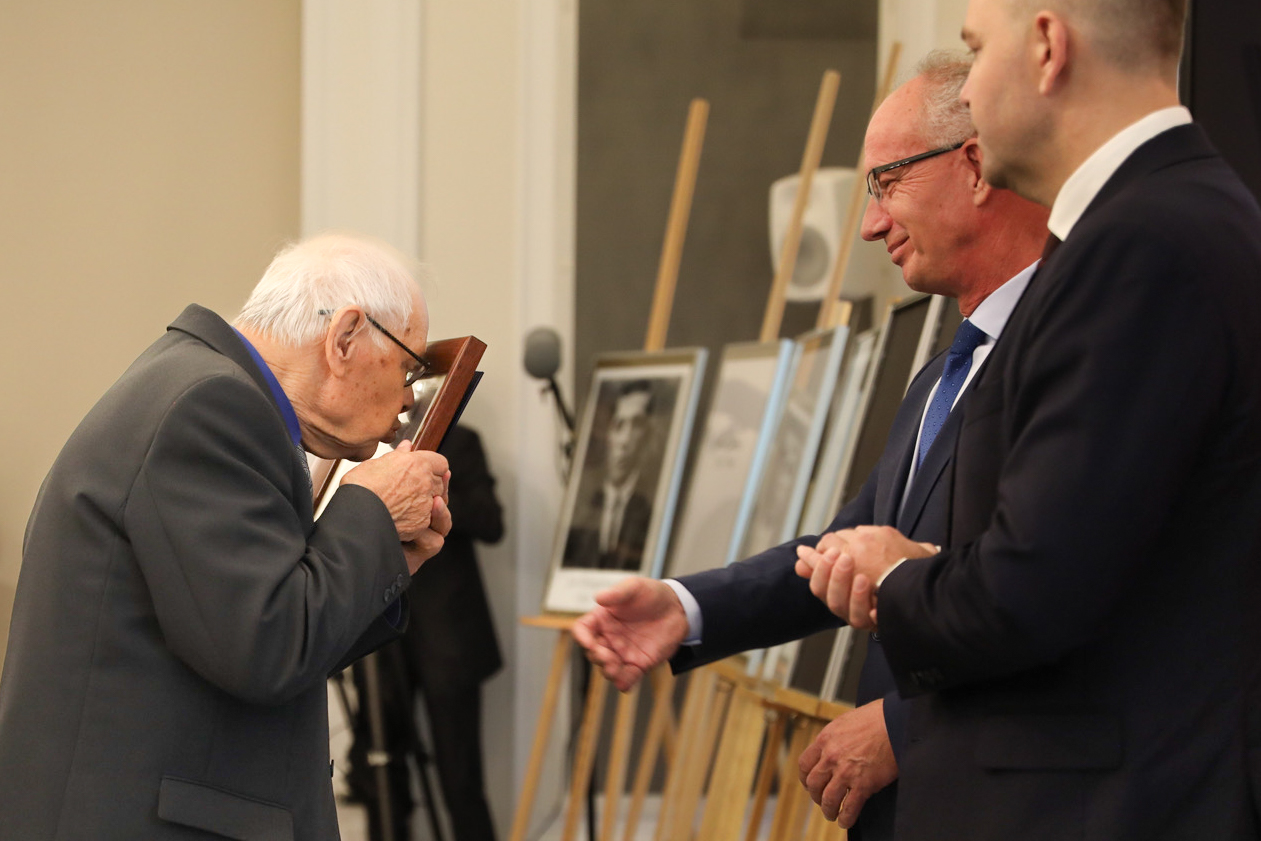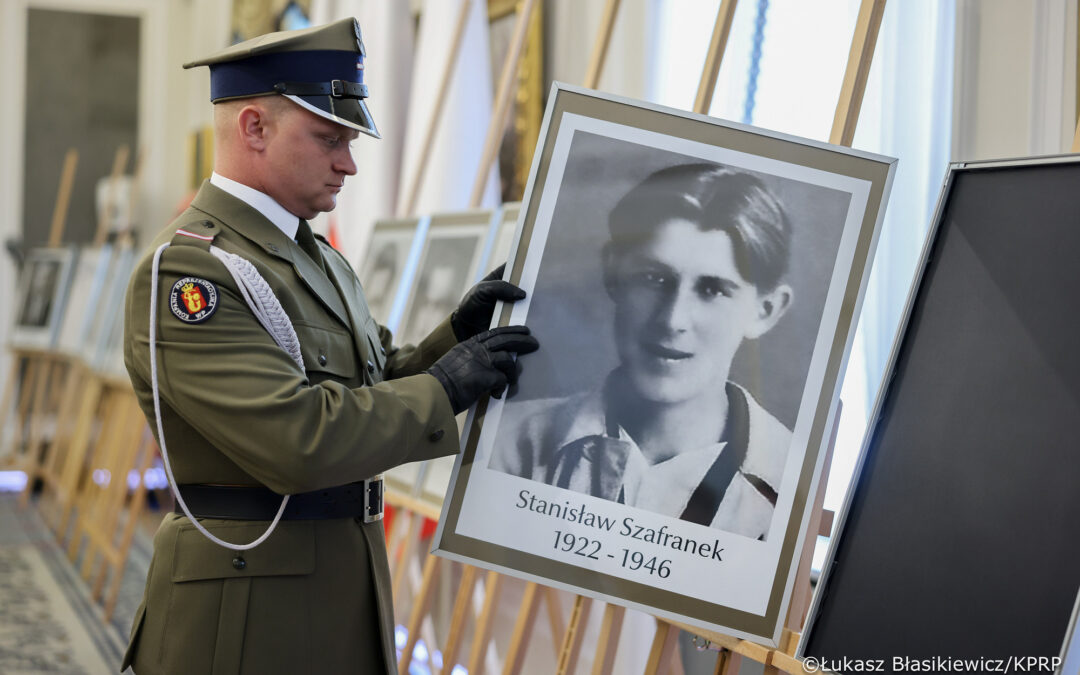Poland has identified the remains of 17 people who were victims of either the Nazi-German invasion and occupation in World War Two or of the communist regime that was installed by the Soviet Union after the war.
Identification documents for the victims – the youngest of whom was a 17-year-old who died in a German-Nazi concentration camp for Polish children – were handed to members of their families by the Institute of National Remembrance (IPN) at a ceremony in the presidential palace of Belvedere in Warsaw.
“We would like to thank the Institute of National Remembrance for the enormous amount of work and effort put into the arduous process of identifying the remains of the fallen,” said Ewa Garczyńska, granddaughter of one of the identified victims, Jan Dzięgielewski, on behalf of the families.

The ceremony to hand identification documents to the victims’ families at Belvedere Palace (photo credit: IPN, under CC BY-NC-ND 3.0 PL)
“Today’s ceremony…is extremely important for the history of Poland and for our families,” she continued. “It adds new heroes to the homeland, and a strong sense of faith to the families that their blood sacrifice was not in vain.”
In a letter read at the ceremony, President Andrzej Duda wrote that “giving the families identification notes is an act of restoring dignity to people who it was attempted to erase from the memory of our nation…and finally giving them a worthy place in our collective memory”.
It also “allows us to end the drama of families who for several decades lived with a sense of loss and painful ignorance about the fate of their loved ones”, added Duda.
Sorry to interrupt your reading. The article continues below.

Notes from Poland is run by a small editorial team and published by an independent, non-profit foundation that is funded through donations from our readers. We cannot do what we do without your support.
The remains of the victims were discovered through the work of the IPN’s search and identification office, which is tasked with finding and identifying victims of Poland’s decades of German-Nazi and communist rule.
One, located in the grounds of a cemetery in Łódź, was Zdzisław Kafarski, who died in 1944 aged 17 at Kinder-KZ Litzmannstadt, a German-Nazi concentration camp for children located in the city from 1942-1945. Thousands of Polish children were imprisoned there.
While Kafarski’s cause of death was officially declared by the camp commandant to have been blood poisoning, a fellow prisoner later testified that the boy had been drowned in a sewage canal by a German guard as a punishment for stealing bread.
Dzięgielewski, meanwhile, died in September 1939 during Poland’s defence against the German invasion that launched the war. He was killed at the age of 28 or 29 while fighting at Modlin Fortress near Warsaw, and his remains were discovered in 2019 during exhumation work there.
Poland’s foreign minister has likened Russia’s abduction of Ukrainian children to Nazi crimes against Polish and Soviet children during WWII in a speech at the UN@sikorskiradek also reminded Moscow of Soviet collaboration with Nazi Germany during the war https://t.co/UW3xJPrdEB
— Notes from Poland 🇵🇱 (@notesfrompoland) September 25, 2024
However, the majority of the newly identified victims – 14 out of 17 – died in the postwar period, between 1946 and 1951. They were victims of the brutal repression imposed by the communist regime installed by the Soviet Union.
Władysław Januszewski, for example, had fought during the war as part of the Home Army (AK), Poland’s main underground resistance force. But, like many AK members, he was detained after the war by the communist security services, brutally interrogated, and sentenced to death.
The bodies of many communist victims from this period were buried in unmarked (often mass) graves, meaning that their loved ones never knew where their remains were located.
A building that served as a Soviet headquarters – and in which prisoners were detained, tortured and executed – has been bought by the Polish government and will be turned into a museum commemorating communist crimes https://t.co/wKGxLowLS9
— Notes from Poland 🇵🇱 (@notesfrompoland) July 8, 2021
One of the IPN’s statutory tasks is to search for and identify such victims. It has so far found the remains of around 2,600 people at several hundred locations in Poland and abroad. However, only around 280 have so far been identified.
One way in which such identifications are achieved is through the IPN’s genetic database, made up of over 5,000 DNA samples from victims and their families.
Last month, Poland held a state funeral for over 700 mostly unidentified victims of mass executions carried out by the German occupiers during World War Two in an area that became known as the “Valley of Death”.
Poland has conducted a state funeral for over 700 victims of mass executions carried out by Germany during WWII in an area that became known as the “Valley of Death”
Over a tonne of human bones were found there, with most of the victims still unidentified https://t.co/Ukq64zjn5x
— Notes from Poland 🇵🇱 (@notesfrompoland) September 3, 2024
Main image credit: Łukasz Błasikiewicz/KPRP

Daniel Tilles is editor-in-chief of Notes from Poland. He has written on Polish affairs for a wide range of publications, including Foreign Policy, POLITICO Europe, EUobserver and Dziennik Gazeta Prawna.



















